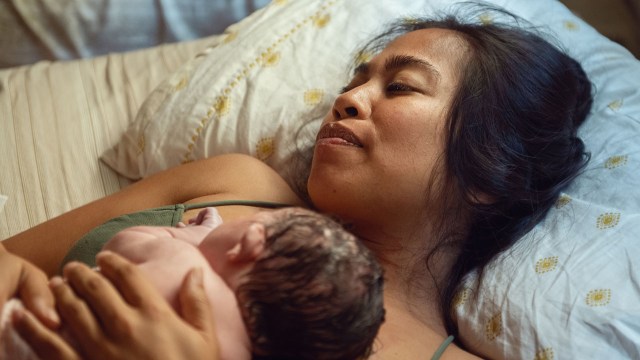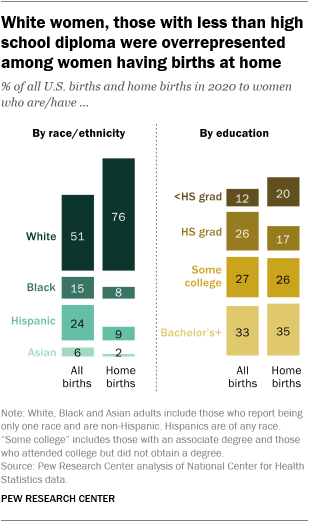
Americans have made many changes in their lives since the COVID-19 pandemic began, and for some this has even extended to the choice of where their babies are born. While the total number of U.S. births declined at the end of 2020 and beginning of 2021, the number of births at home rose during the pandemic’s first year.
Both the number and proportion of U.S. home births were substantially higher in 2020 than in previous years, according to a Pew Research Center analysis of data from the National Center for Health Statistics. The number of home births rose from 38,506 in 2019 to 45,646 in 2020, reflecting a 19% increase. Meanwhile, the share of U.S. births that took place at home was about 1.3% in 2020, compared with 1% in 2019.

Estimates of home births and all births are based on data from the National Vital Statistics System of the National Center for Health Statistics (NCHS), which is part of the Centers for Disease Control and Prevention (CDC). The data was extracted from CDC reports and 2019 and 2020 Vital Statistics Natality Birth Data Public Use Files provided by the National Bureau of Economic Research.
The U.S. Standard Certificate of Live Birth includes a checkbox item on the place of birth with five options: hospital, freestanding birth center, home birth, clinic/doctor’s office, and other. Home birth is defined by the CDC as a birth occurring at a private residence.
Experts and media outlets have reported that pandemic-related restrictions – as well as fear of contracting the COVID-19 virus – likely influenced women’s decisions to give birth at home. The rise in home births may be partly due to measures limiting who could be present in the delivery room, restrictions on visitors seeing patients during hospital stays, and the possibility that mothers suspected of having COVID-19 could be separated from their newborn children.
Overall, births in hospitals declined in the United States in 2020, while births in other locations – including the home – grew. The number of deliveries in birthing centers rose from 20,043 in 2019 to 21,884 in 2020, representing an increase of more than 9%.
The proportion of U.S. home births changed as 2020 went on, reaching its highest level after the World Health Organization declared the coronavirus outbreak a pandemic in March of that year. Home deliveries accounted for about 1% of total U.S. births in January 2020. From January onward, the share of home births grew each month until peaking in May, when deliveries at home represented 1.5% of total births. The share of births at home subsequently decreased to 1.3% in June and remained around this level until the end of 2020.
Demographic differences in home births
The share of U.S. births that took place at home varied across racial and ethnic groups in 2020. In that year, 1.9% of births to White women and 0.7% of births to Black women were home births. Among Hispanic and Asian women, the share of births at home were 0.5% and 0.3%, respectively.
There were also variations across educational groups. Among women with less than a high school education, home births represented 2.1% of all births in 2020. Conversely, among those with a bachelor’s degree, home births accounted for 1.3% of total births that year.
Between 2019 and 2020, the number of home births increased among most demographic groups. However, the growth was greatest among Black and Hispanic women, with increases of 32% and 28%, respectively, from 2019. The increase in the number of home births was also higher among women with a bachelor’s degree (23% rise) than among those with less than a high school education (8%).
The profile of U.S. women who delivered their babies at home in 2020 differed from the general population of women giving birth. Race, ethnicity and educational attainment, in particular, played a role in who gave birth at home.

White women were overrepresented among home births – that is, they accounted for a higher share of home births than for all births. While White women represented 51% percent of women giving birth in 2020, they accounted for 76% of home births in the same year. And while women with less than a high school education represented 12% of all births in 2020, they accounted for 20% of the women who had their children at home.
Women with more children and those in their 30s were also overrepresented among those who gave birth at home. Women with three or more previous live births accounted for about 13% of total births in 2020. However, this group represented almost a third (32%) of women giving birth at home. Conversely, women who had never previously had a live birth accounted for 39% of all births in 2020 but only 18% of home births. Women ages 30 to 39 accounted for 45% of total births but represented 53% of the births at home.
Geographic differences
In addition to racial, ethnic and educational variations, there were also important geographical variations in the share of women giving birth at home.

In 2020, the five states with the largest share of births at home were Idaho (3.2%), Vermont (3.0%), Wisconsin (2.8%), Utah (2.6%) and Montana (2.6%). These states also had the largest shares of home births in the country in 2019.
From 2019 to 2020, there was a widespread rise in births happening at home, but the increases also varied by state. The greatest increases took place in South Dakota (which saw a 61% rise in the number of home births), South Carolina (59%), Delaware (48%), Rhode Island (48%) and Massachusetts (42%).
